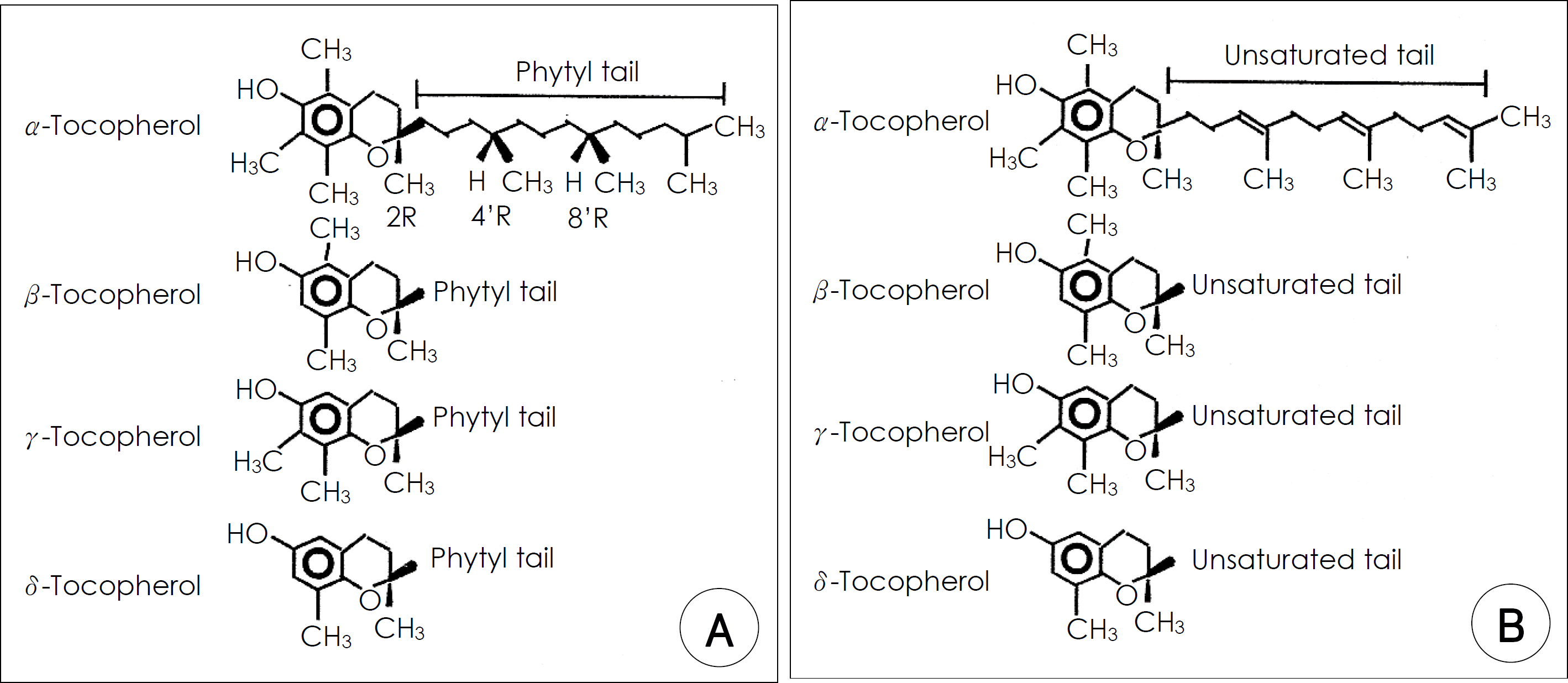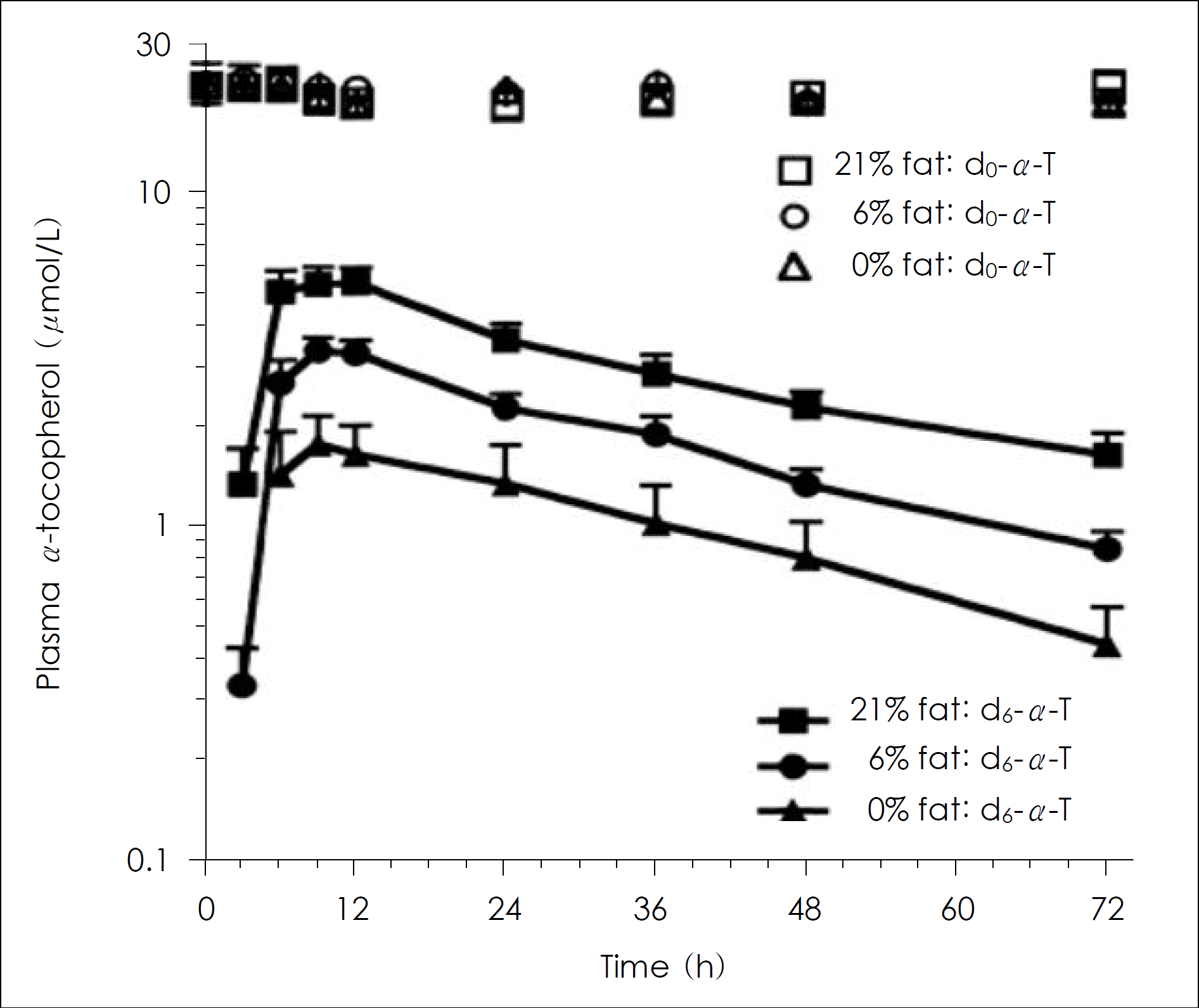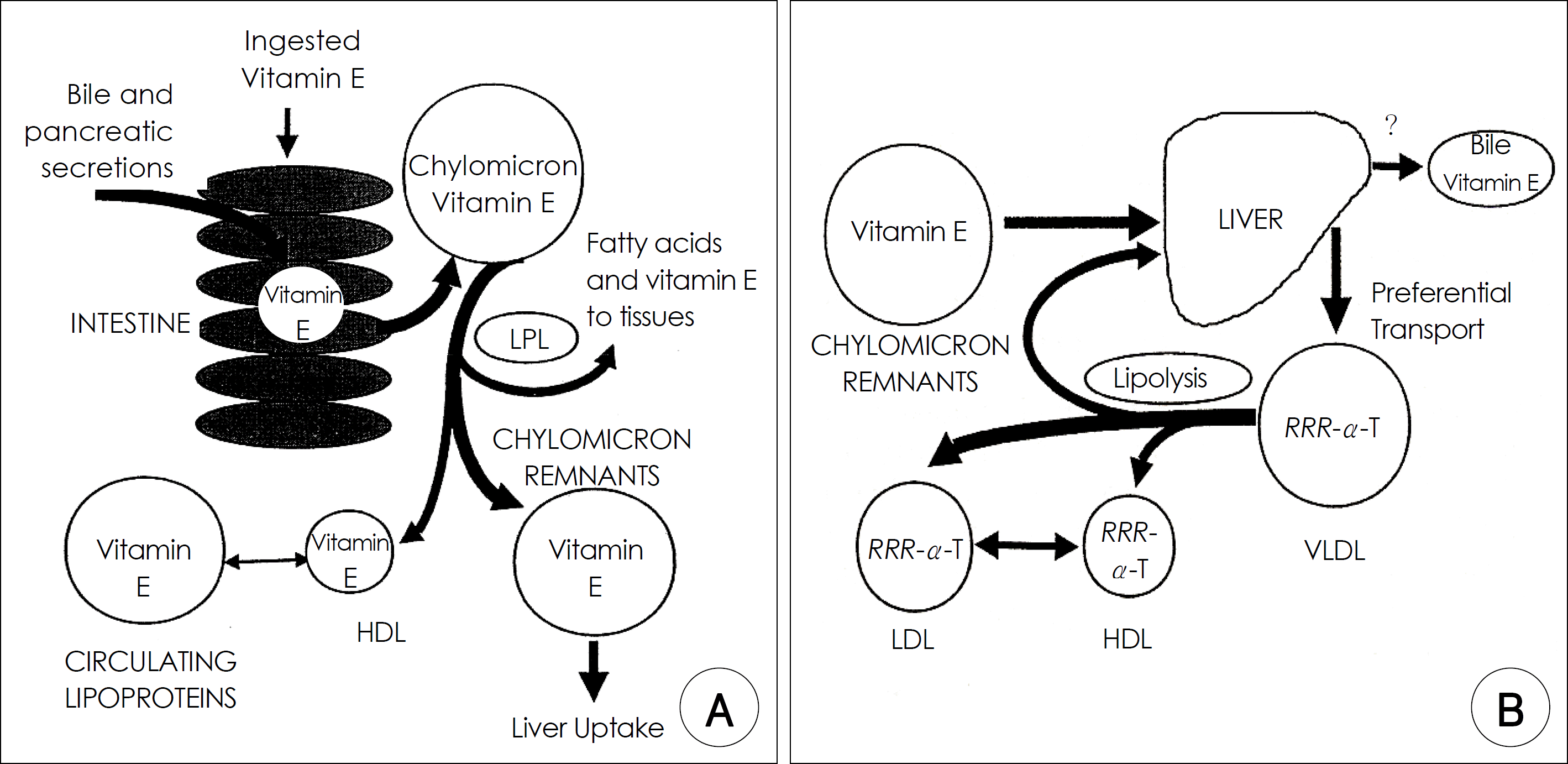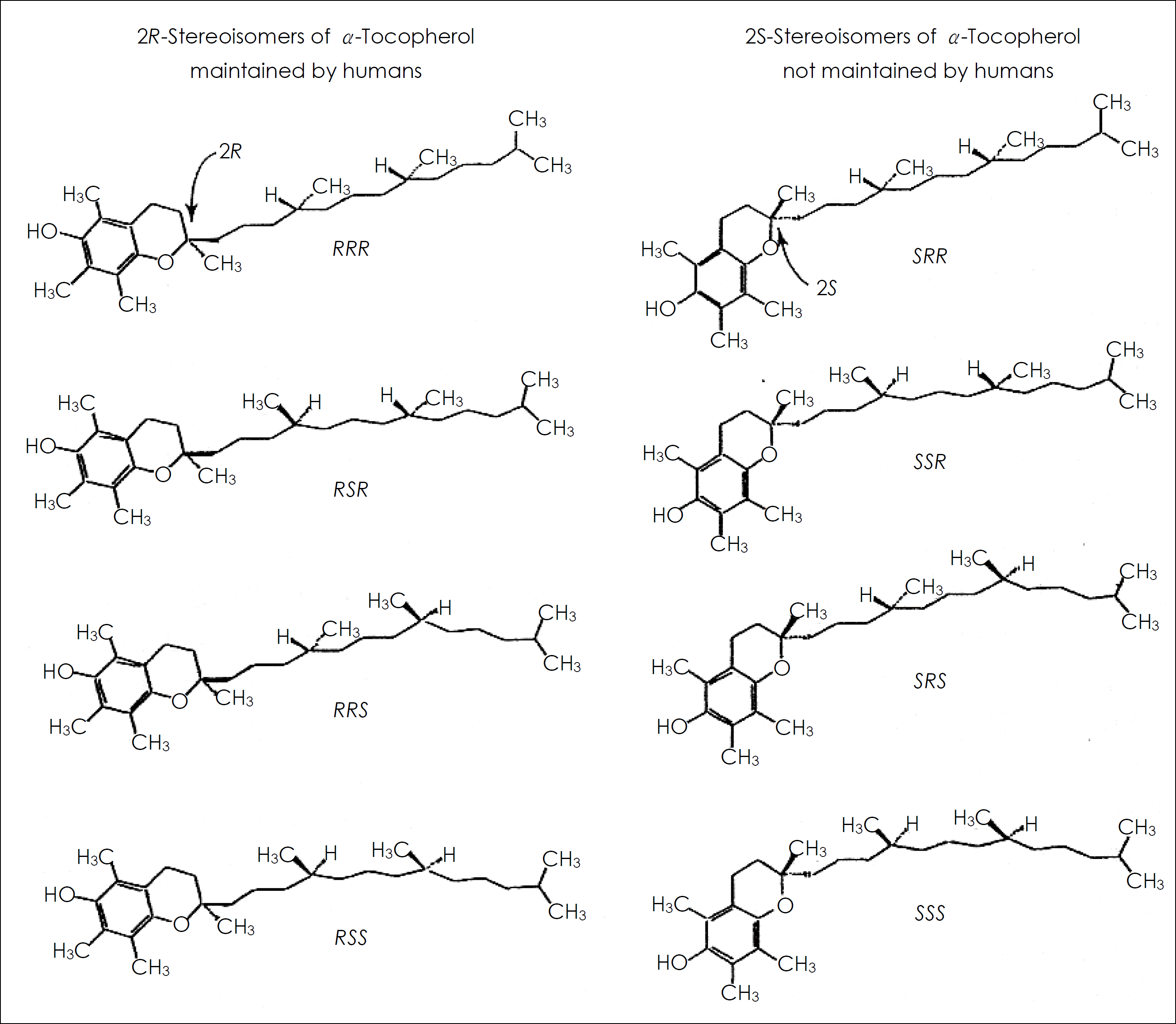1). Combs GF Jr. Vitamin E. In: The Vitamins, Fundamental Aspects in Nutrition and Health. New York: Academic Press;1998. p. 189–223.
2). Hu JN, Zhu XM, Adhikari P, Li D, Kim IH, Lee KT. Determination of tocopherol contents in refined edible oils using HPLC method. J Food Sci Nutr. 2009; 14(3):260–264.
3). Korea Health Industry Development Institute. Development of Nutrient Database -2. Vitamin Composition of Foods -. 2002.
4). Food and Nutrition Board, Institute of Medicine. Dietary Reference Intakes for Vitamin C, Vitamin E, Selenium, and Carotenoids. Washington, DC: National Academies Press;2000.
5). Dillard CJ, Gavino VC, Tappel AL. Relative Antioxidant effec-tiveness of α -tocopherol and δ -tocopherol in iron-loaded rats. J Nutr. 1983; 113(11):2266–2273.
6). Jeanes YM, Hall WL, Ellard S, Lee E, Lodge JK. The absorption of vitamin E is influenced by the amount of fat in a meal and the food matrix. Br J Nutr. 2004; 92(4):575–579.

7). Bruno RS, Leonard SW, Park S, Zhao Y, Traber MG. Human vitamin E requirements assessed with the use of apple fortified with deuterium-labeled α -tocopheryl acetate. Am J Clin Nutr. 2006; 83(2):299–304.
8). Leonard SW, Good CK, Gugger ET, Traber MG. Vitamin E bio-availability from fortified breakfast cereals greater than that from encapsulated supplements. Am J Clin Nutr. 2004; 79(1):86–92.
9). Roxbrough HE, Burton GW, Kelly FJ. Inter- and itra-invdividual variation in plasma and red blood cell vitamin E after supplementation. Free Radic Res. 2000; 33:437–446.
10). Reboul E, Klein A, Bietrix F, Gleize B, Malezet-Desmooulins C, Schnerider M, Margotat A, Lagrost L, Collet X, Borel P. Scavenger receptor class B type I (SR-BI) is involved in vitamin E transport across the enterocyte. J Biol Chem. 2006; 281(8):4739–4745.

11). Anwar K, Kayden HJ, Hussain MM. Transport of vitamin E by differentiated Caco-2 cells. J Lipid Res. 2006; 47:1261–1273.

12). Traber MG, Olivecrona T, Kayden HJ. Bovine milk lipoprotein lipase trnasfers tocopherol to human fibroblasts during triglyceride hydrolysis in vitro. J Clin Invest. 1985; 75:1729–1734.
13). Traber MG. vitamin E: In Shils ME, Olson JA, Shike M, Ross AC eds. Modern Nutrition in Health and Disease. 9th edition.Baltimore, MD: Williams & Wilkins;1999. p. 347–362.
14). Sato Y, Hagiwarsa K, arai H, Inoue K. Purification and characterization of the alpha-tocopherol transfer from the rat liver. FEBS Lett. 1991; 288(1):41–45.
15). Traber MG, Rudel LL, Burton GW, Hughes L, Ingold KU, Kayden HJ. Nascent VLDL from liver perfusions of cynomolgus monkys are preferentially enriched in RRR-compared with SRR-alpha tocopherol: Studies using deuterated tocopherols. J Lipid Res. 1990; 31(4):687–694.
16). Panagabko C, Morley S, Hernandez M, Cassolato P, Gordon H, Manor D, Atkinson J. Ligand specificity in the CRAL-TRIO protein family. Biochemistry. 2003; 42(21):6467–6474.

17). Dutta-Roy AK. Leishman DJ, Gordon MJ, Campbell FM, Duthie GG. Identification of a low molecular mass (14.2 kDa) alpha-tocopherol-binding protein in the cytosol of rat liver an heart. Biochem Biophy Res Commun. 1993; 196(3):1108–1112.
18). Taber MG, Kayden HJ. Vitamin E is delivered to cells via high affinity receptor for low density lipoprotein. Am J Clin Nutr. 1984; 40:747–751.
19). Cohn W, Goss-Sampson MA, Grun H, Muller DP. Plasma clearance and net uptake of alpha-tocopherol an dlow-density lipoprotein by tissues in WHHL and control rabbits. Biochem J. 1992; 287:247–254.
20). ‘Mardones P, Strobel P, Miranda S, Leighton F, Quinones V, Amigo L, Rozowski J, Rigotti A. Alpha-tocopherl metabolism in abnormal in scavenger receptor class B type I (SR-BI)-deficient mice. J Nutr. 2002; 132:443–449.
21). Rigotti A, Miettinen HE, Krieger M. The role of the high-density lipoprotein receptor SR-BI in lipid metabolism of endocrine and other tissues. Endocr Rev. 2003; 24:357–387.
22). Handelman GJ, Epstein JP, Spiegelman D, Machlin LJ, Dratz EA. Human adipose alpha-tocopherol and gamma-tocopherol kinetics during and after 1 y of alpha-tocopherol supplementation. Am J Clin Nutr. 1994; 59(3):1025–1032.
23). El-Sohemy A. Baylin A, Ascherio A, Kabagambe E, Spiegelman D, Campos H. Population-based study of alpha- and gamma-tocopherol in plasma and adipose tissue as biomarkers of intake in Costa Rican adults. Am J Clin Nutr. 2001; 74(3):356–363.
24). Brigelius-Flohé R, Traber MG. Vitamin E: function and metabolism. FASEB J. 1999; 13(10):1145–1155.
25). Zempleni J, Rucker RB, McCormick DB, Suttie JW. Vitamin E (Traber MG) in ‘Handbook of Vitamins’ 4th ed. 2007. 153–174.
26). Yano T, Yajima S, Hagiwara K, Kumadaki I, Yano Y, Otani S, Uchida M, Ichikawa T. Vitamin E inhibits cell proliferation and the activation of extracellular signal-regulated kinase during the promotion phase of lung tumorigenesis irrespective of antioxidative effect. Carcinogenesis. 2000; 21(11):2129–2133.

27). Korea Centers for Disease Control and Prevention. The third Korea National Health and Nutrition Examination Survey (KNH-ANES III). 2005.
28). Hosomi A, Arits M, Sato Y, Kiyose G, Ueda T, Iragashi O, Arai H, Inuoe K. Affinity for alpha-tocopherol transfer protein as a determinant of the biological activities of vitamin E analogs. FEBS Lett. 1997; 409(1):105–108.
29). Burton GW, Traber MG, Acuff RV, Walters DN, Kayden H, Hughes L, Ingold KU. Human plasma and tissue α -tocopherol concentrations in response to supplementation with deuterated natural and synthetic vitamin E. Am J Clin Nutr. 1998; 67:669–684.
30). Bieri JG, Evarts RP. Gamma tocopherol: metabolism, biological activity and significance in human vitamin E nutrition. Am J Clin Nutr. 1974; 27(9):980–986.

31). Weber C, Podda M, Rallis M, Thiele JJ, Traber MG, Packer L. Efficacy of topically applied tocopherols and tocotrienols in protection of murine skin from oxidative damage induced by UV-irradiation. Free Radic Biol Med. 1997; 22:761–769.

32). Handelman GJ, Machlin LJ, Fitch K, Weiter JJ, Dratz EA. Oral α -tocopherol supplements decrease plasma γ -tocopherol levels in humans. J Nutr. 1985; 115(6):807–813.
33). Kiyose C, Saito H, Kaneko K, Hamamura K, Tomioka M, Ueda T. Igarashi O.α -Tocopherol affects the urinary and biliary excretion of 2,7,8-trimethyl-2(2’-carboxyethly)-6-hydroxychroman, gamma-tocopherol metabolites in rats. Lipids. 2001; 36(5):467–472.
34). Leonard SW, Paterson E, Atkinson JK. Ramakrishnan R, Cross CE, Traber MG. Studies in humans using deuterium-labeledα - and γ -tocopherol demonstrate faster γ -tocopherol disappearance and greater γ -metabolite production. Free Radic Biol Med. 2005; 38(7):857–866.
35). Cooney RV, Franke AA, Harwood PJ, Hatch-Pigott V, Custer LJ, Mordan LJ. γ -tocopherol detoxification of nitrogen dioxide: superiority to α -tocopherol. Proc Natl Acad Sci USA. 1993; 90:1771–1775.
36). Goss SP, Hogg N, Kalyanaraman B. The effect of on nitration of γ -tocopherol by peroxynitrite. Arch Biochem Biophys. 1999; 363:333–340.
37). Jiang Q, Elson-Schwab I, Courtemanche C, Ames BN. γ -toco-pherol and its major metabolite, in contrast to α -tocopherol, inhibits cyclooxigenase activitiy in macrophages and epithelial cells. Proc Natl Acad Acid USA. 2000; 97:11494–11499.
38). Saldeen T, Li D, Mehta JL. Differential effects of α - and γ -tocopherol on low-density lipoprotein oxidation, superoxide activity, pletelet aggregation and arterial thrombogenesis. J Am Coll Cardiol. 1999; 34:1208–1215.
39). Liu M, Wallmon A, Olsson-Mortiock C, Wallin R, Sadeen T. Mixed tocopherols inhibit platelet aggregation in humans: potential mechanisms. Am J Clin Nutr. 2003; 77:700–706.

40). Ohrvall M, Sundolf G, Vessby B. Gamma, but not alpha, tocopherol levels in serum are reduced in coronary heart disease patients. J Intern Med. 1996; 239:111–117.

41). Kristenson M, Zieden B, Kucinskiene Z. antioxidant status ad mortality from coronary heart disease in Lithuaniann and Swedish men aged 50. BMJ. 1997; 314:629–633.
42). Kushi LH, Folsom AR, Prineas R, Mink PJ, Wu Y, Bostick RM. Dietary antioxidant vitamins and death from coronary heart disease in postmenopausal women. N Eng J Med. 1996; 334:156–162.

43). Huang HY, Alberg AJ, Norkus E. prospective study of antioxidant micronutrients in the blood and the risk of developing prostate cancer. Am J Epidemiol. 2003; 157:335–344.

44). Helzlsouer KJ, Huang HY, Alberg AJ, Hoffman S, Burke A, Norkus EP, Morris JS, Comstock GW. Association between alpha-tocopherol, gamma-tocopherol, selenium, and subsequent prostate cancer. J Natl Cancer Inst. 2000; 92(24):2018–2023.

45). Mahabir S, Schendel K, Dong YQ, Barrera SL, Spitz MR, Forman MR. Dietary alpha-, beta-, gamma- and delta-tocopherols in lung cancer risk. Int J Cancer. 2008; 123(5):1173–1180.
46). Yap SP, Yuen KH, Lim AB. Influence of route of administration on the absorption and disposition of alpha-, gamma- and delta-tocotrienols in rats. J Pharm Pharmacol. 2003; 55(1):53–58.
47). Ikeda I, Imasato Y, Sasaki E, Sugano M. Lymphatic transport of alpha-, gamma-, delta-tocotrienols and alpha-tocopherol in rats. Int J Vitam Nutr Res. 1996; 66:217–221.
48). Birringer M, Pfluger P, Kluth D, Lands N, Brigelius-Flohé R. Identities and differences in the metabolism of tocoptrienols and tocopherols in HepG2 cells. J Nutr. 2002; 132:3113–3118.
49). Mustard VK, Smith CA, Ruey PP, Edens NK, DeMichele SJ. Supplementation with 3 compositionally different tocotrienol supplements does not improve dardiovascular disease risk factors in men and women with hypercholesterolemia. Am J Clin Nutr. 2002; 76:1237–1243.
51). Roy S, Lado BH, Khanna S, Sen CK. Vitamin E sensitive genes in the developing rat fetal brain: a high-density oligonucleotide microarray analysis. FEBS Lett. 2002; 530(1-3):17–23.

52). Quershi AA, Mo H, Packer L, Peterson DM. Isolation and identification of novel tocotrienols from rice bran with hypocholesterolemic, antioxidant, and antitumor properties. J Agric Food Chem. 2000; 48:3130–3140.
53). O’Byrne D, Grundy S, Packer L, Devaraj S, Baldenius K, Hoppe PP, Kraemer K, Jialal I, Traber MG. Studies of LDL oxidation following alpha-, gamma-, or delta-tocotrienyl acetate supplementation of hypercholesterolemic humans. Free Radic Biol Med. 2000; 29(9):834–845.
54). Cicero AF, Gaddi A. Rice bran and gama-oryzanol in the treatment of hyperlipoproteinemias and other conditions. Phytother Res. 2001; 15:277–289.
55). Quershi AA, Sami SA, Salser WA, Khan FA. Dose-dependent suppression of serum cholesterol by tocotrienol-rich fraction (TRF-25) of rice bran in hypercholesterolemic humans. Atherosclerosis. 2002; 162:199–207.

56). Noguchi N, Hanyu R, Nanaka A, Okimoto Y, Kodama T. Inhibition of THP-1 cell adhesion to endothelial cells by alpha-tocopherol and alpha-tocotrienol is dependnent on intracellular concentration of the antioxidants. Free Radic Biol Med. 2003; 34:1614–1620.
57). Newaz MA, Yousefipour Z, Nawal N, Adeeb N. Nitric oxide synthesis activity in blood vessels of spontaneously hypertensive rata: antioxidant protenction by gamma-tocotrienol. J Physiol Phrama-col. 2003; 54:319–327.
58). McIntyre BS, Briski KP, Gapor A, Sylvester PW. Antiproliferative and apoptotic effects of tocopherols and tocotrienols on preneoplastic and neoplastic mouse mammaty epithelial cells (445 44). Proc Soc Exp Biol Med. 2000; 224(4):292–301.
59). Sylvester PW, Nachnani A, Shah S, Briski KP. Role of GTP-binding proteins in reversing the antiproliferative effects of tocotrienols in preheoplastic mammary epithelial cella. Asia Pac J Clin Nutr. 2002; 11(suppl 7):S452–S459.
60). Takahashi K, Loo G. Disruption of mitochondria during tocotrienol-induced apoptosis inMDA-MB-231 human breast cancer cells. Biochem Pharmacol. 2004; 67:315–324.
61). Mo H, Elson CE. Studies of the isoprenoid-mediated inhibition of mevalonate synthesis applied to cancer chemotherapy and che-mo prevention. Exp Biol Med. 2004; 229:567–585.
62). Sen CK, Khanna S, Roy S, Packer L. Molecular basis of vitamin E action. Tocotrienol potently inhibits glutamate-induced pp60 (c-Src) kinase activation and death of HT4 neuronal cells. J Biol Chem. 2000; 275:13049–13055.
63). Khanna S, Roy S, Ryu U, Bahadduri P, Swaan PW, Ratan RR, Sen CK. Molecular basis of vitamin E action: tocotrienol modulates 12-lipoxygenas, a key mediator of glutamate-induced neurodegeneration. J Biol Chem. 2003; 278:43508–43515.







 PDF
PDF ePub
ePub Citation
Citation Print
Print




 XML Download
XML Download